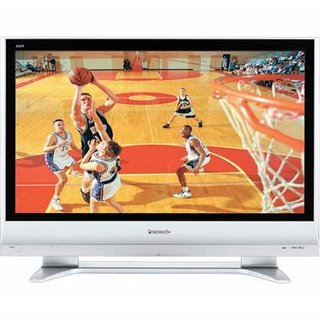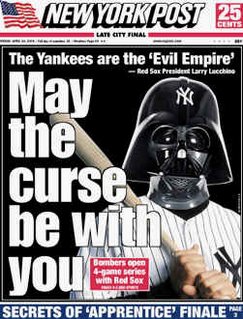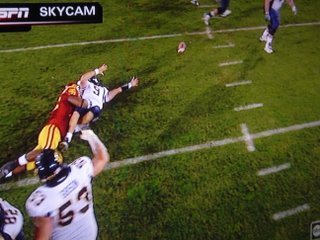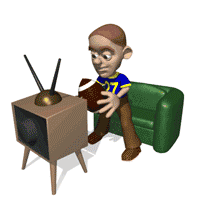
Last week, BDD @ KSK wrote "We're in mid-November now. The heart of the football season." His look at
preparing for the playoffs was a bit different than what follows, but it inspired me to provide a guide on a subject I know a little bit about: High-Definition Television.
I was lucky enough to win a 26" LCD in a
contest last July. That screen was good enough to show the quality difference between regular and HD programing, which must be seen to be appreciated. But I've been researching current models so I could upgrade to something I wouldn't need lasik to view from nine feet away. If you're still without an HD set, even if you own the 35" Sony Wega that was all the rage two years ago, it's time to get primed for the playoff run.
As with most things in life, so it is with buying an HDTV. There are
two types of people: People who want a television that will last them the next ten years no matter the cost today, and people who want an HD set that's perfectly fine for now without breaking the bank. Let's break it down.
 The future-proof HDTV: Sharp Aquos LC-52D62U - LCD ($3,200)
The future-proof HDTV: Sharp Aquos LC-52D62U - LCD ($3,200)This is the sixth generation of Sharp's bestselling LCD panel, and the best choice for someone looking to buy an HDTV today. The screen size is huge, especially for an LCD. Historically, LCD manufacturers had trouble selling such a large display at a reasonable cost. A year ago, Sharp was selling its 65-inch LCD for $20,000. I'm sure you've seen ads for larger HDTVs, but most of those are "DLP" TVs, which are not flat panels like LCDs or plasmas; DLPs weigh twice as much and are more than twice as thick. That means you can't hang a DLP on the wall. The elegance of a beautiful HDTV hanging on the wall is a key selling point you can use on your wife or girlfriend. One estimate shows women driving flat screen purchases over DLPs about
60% of the time, so if you've got a lady in your life, a flat screen is the way to go.
Aside from the large screen, the technical specs of this LCD put it far and above anything else on the market at this price. This LCD has
true 1080p. That number refers to the resolution on the screen and measures the pixel count of the display. You've been able to buy an HDTV with enough pixels to
display 1080p for over a year, but HDTVs sold before... well... pretty much now,
couldn't accept a 1080p input. This Aquos does accept 1080p, which means that a few years from now, when you have a bunch of HD-DVDs or Blu-Ray discs (e.g., Playstation 3), and when all HD content is broadcast in 1080p, your HDTV won't already be outdated.
Two more reasons this screen is so great... Its contrast ratio of 10,000:1 (basically, how dark it displays the color black; most LCDs can only get to dark gray) and its screen refresh rate of 4ms (how well it displays fast-moving action like sports). Compare those specs to other LCDs and you'll see why, if you've got the free cash to spend, the Sharp Aquos LC-52D62U is just about perfect.
Honorable Mention: Sony Bravia KDL-52XBR2 (
$5,500)
This Sony gives you the same ability as the Aquos to accept true 1080p inputs, the same screen size, and a slightly inferior contrast ratio and refresh rate. The price premium gets you a beautiful glass bezel around the screen and BRAVIA Engine PRO image processing. Image processing is the method by which your rectangular HDTV makes square pictures look good, and it's useful for people who watch a lot of regular-definition programming or standard DVDs. But in five years the importance of image processing will be diminished because so little programming will be shown in a format other than 1080p. If money is no object, the Sony is the better HDTV, but the Aquos' value gives it the edge in this comparison.
 The HDTV to enjoy without breaking the bank: Panasonic TH-42PX60U - Plasma ($1,300)
The HDTV to enjoy without breaking the bank: Panasonic TH-42PX60U - Plasma ($1,300)After all that talk about accepting 1080p inputs and viewing 1920 x 1080 pixels, why would I recommend a screen that can only display up to 720p (1366 x 768)? Because sports are broadcast today in either 720p - on
ESPN/ABC and
Fox - or in 1080i on
CBS and
NBC. Right now the only 1080p content available comes from new high-definition DVDs and the Playstation 3. If you don't have either of those, you can get by with a 720p tv for at least a couple more years. In fact, Fox claims that
720p is better than 1080i (not 1080p, mind you) for viewing sports.
Because the Panasonic is a plasma not an LCD, a 10,000:1 contrast ratio is to be expected; the color black looks great on this screen. A plasma is thin like an LCD, so you can hang it on the wall. The drawback to plasma, that
an image can "burn in" to the screen, is something you should be aware of, but if you're careful, this plasma will give you a much better picture than comparably-priced LCD tvs.
As Drew wrote: "You have your marching orders." Now, just
don't fall for the extended warranty!













 Everyone seems blown away by the fact that the Red Sox just
Everyone seems blown away by the fact that the Red Sox just 